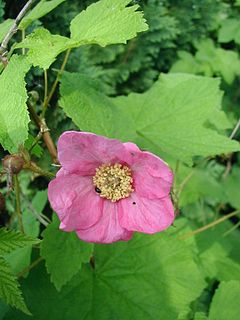
Rubus chamaemorus is a species of flowering plant in the rose family Rosaceae, native to cool temperate regions, alpine and arctic tundra and boreal forest. This herbaceous perennial produces amber-colored edible fruit similar to the blackberry. English common names include cloudberry, nordic berry, bakeapple, knotberry and knoutberry, aqpik or low-bush salmonberry, and averin or evron.

The raspberry is the edible fruit of a multitude of plant species in the genus Rubus of the rose family, most of which are in the subgenus Idaeobatus. The name also applies to these plants themselves. Raspberries are perennial with woody stems. World production of raspberries in 2019 was 822,493 tonnes, led by Russia with approximately 21% of the total.

Rubus spectabilis, the salmonberry, is a species of bramble in the rose family Rosaceae, native to the west coast of North America from west central Alaska to California, inland as far as Idaho. Like many other species in the genus Rubus, the salmonberry plant bears edible fruit, typically yellow-orange or red in color, resembling raspberries in appearance.

Rubus phoenicolasius is an Asian species of raspberry in the rose family, native to China, Japan, and Korea.

Rubus occidentalis is a species of Rubus native to eastern North America. Its common name black raspberry is shared with other closely related species. Other names occasionally used include bear's eye blackberry, black cap, black cap raspberry, and scotch cap.

Rubus parviflorus, commonly called thimbleberry, is a species of Rubus native to northern temperate regions of North America. It bears edible red fruit similar in appearance to a raspberry, but shorter, almost hemispherical. Because the fruit does not hold together well, it has not been commercially developed for the retail berry market, but is cultivated for landscapes. The plant has large hairy leaves and no thorns.

Rubus odoratus, the purple-flowered raspberry, flowering raspberry, or Virginia raspberry, is a species of Rubus, native to eastern North America, from Nova Scotia west to Ontario and Wisconsin, and south along the Appalachian Mountains as far as Georgia and Alabama.

Rubus leucodermis, also called whitebark raspberry, blackcap raspberry or blue raspberry, is a species of Rubus native to western North America, from Alaska south as far as California, Arizona, New Mexico, and Chihuahua.

Rubus niveus is a species of Rubus native to southern Asia, from Afghanistan east through India and China to Taiwan and the Philippines, south to Sri Lanka and Malaysia, and north to Gansu in China.

Rubus saxatilis, or stone bramble, is a species of bramble widespread across Europe and Asia from Iceland and Spain east as far as China. It has also been found in Greenland.

Rubus ursinus is a North American species of blackberry or dewberry, known by the common names California blackberry, California dewberry, Douglas berry, Pacific blackberry, Pacific dewberry and trailing blackberry.

Rubus sieboldii, the Molucca raspberry, is a flowering plant in the genus Rubus. The species is native to Australia, and mid-western Asia, in the Himalaya Mountains and foothills. The shrubs prefer low wetland areas, with very good sun exposure, though the plants can tolerate moderate shade.

Rubus rosifolius,, also known as roseleaf bramble, Mauritius raspberry, thimbleberry,Vanuatu raspberry and bramble of the Cape is a prickly subshrub native to rainforest and tall open forest of the Himalayas, East Asia, and eastern Australia.

Rubus moluccanus, the Molucca bramble or broad-leaf bramble, is a scrambling shrub or climber, native to moist eucalyptus forest and rainforest of eastern Australia, distributed from Queensland to Victoria and North-East Indian states of Assam, Meghalaya, Nagaland and Arunachal Pradesh. Molucca bramble leaves are simple with 3-5 lobes, 2–15 cm long, and 3–10 cm wide, and the lower surface tomentose. Flowers pinkish red or white. Red fruit is 1.2 cm wide.

Rubus hayata-koidzumii is probably better known by the (illegitimate) synonym Rubus calycinoides or as creeping raspberry. It is a low-growing member of the genus Rubus which also includes better known edibles such as the blackberry, raspberry, boysenberry, and thimbleberry.

Rubus flagellaris, the northern dewberry, also known as the common dewberry, is a North American species perennial subshrub species of dewberry, in the rose family. This dewberry is distributed across much of Canada, Mexico, and the United States. It grows in diverse habitats ranging from drier savannas to temperate deciduous forests.

Rubus argutus is a North American species of prickly bramble in the rose family. It is a perennial native to the eastern and south-central United States from Florida to Texas, Missouri, Illinois, and Maine. Common names are sawtooth blackberry or tall blackberry because of its habit of growing up to 2 meters in height.

Rubus biflorus is a flowering plant in the genus Rubus, in the family Rosaceae. It is a deciduous, suckering shrub, native to East Asia, growing 3m to 3.5m, which is grown ornamentally for its arching white thorny stems in Winter. The underside of the pinnate leaves also has a white bloom. The flowers are white, sometimes followed by edible yellow fruits. This plant has gained the Royal Horticultural Society's Award of Garden Merit.

Rubus tricolor is an evergreen prostrate shrub, native to southwestern China. Leaves are dark green above, pale green below, and stems have red bristles. It has white flowers in summer, and edible red fruit. It grows approximately 0.3 m (1 ft) high and usually forming a vigorously spreading, dense mat. In cultivation it is mainly used as groundcover. Common names include Chinese bramble, groundcover bramble, creeping bramble, Korean raspberry, Himalayan bramble, Groundcover Raspberry. In Chinese it is called 三色莓.

Rubus pectinellus, commonly known as atibulnak, is a species of brambles in the rose family. It is native to Japan, southern China, Taiwan, and the Philippines. They usually grow in forests and valleys at elevations of 700 to 3,000 m. It is also known as kobanofuyuichigo (コバノフユイチゴ) in Japanese and huáng pào (黄泡) in Mandarin Chinese. Atibulnak fruits are edible, either raw or cooked, and have a pleasant subacid flavor. The leaves are also eaten as a vegetable in the Philippines.




















